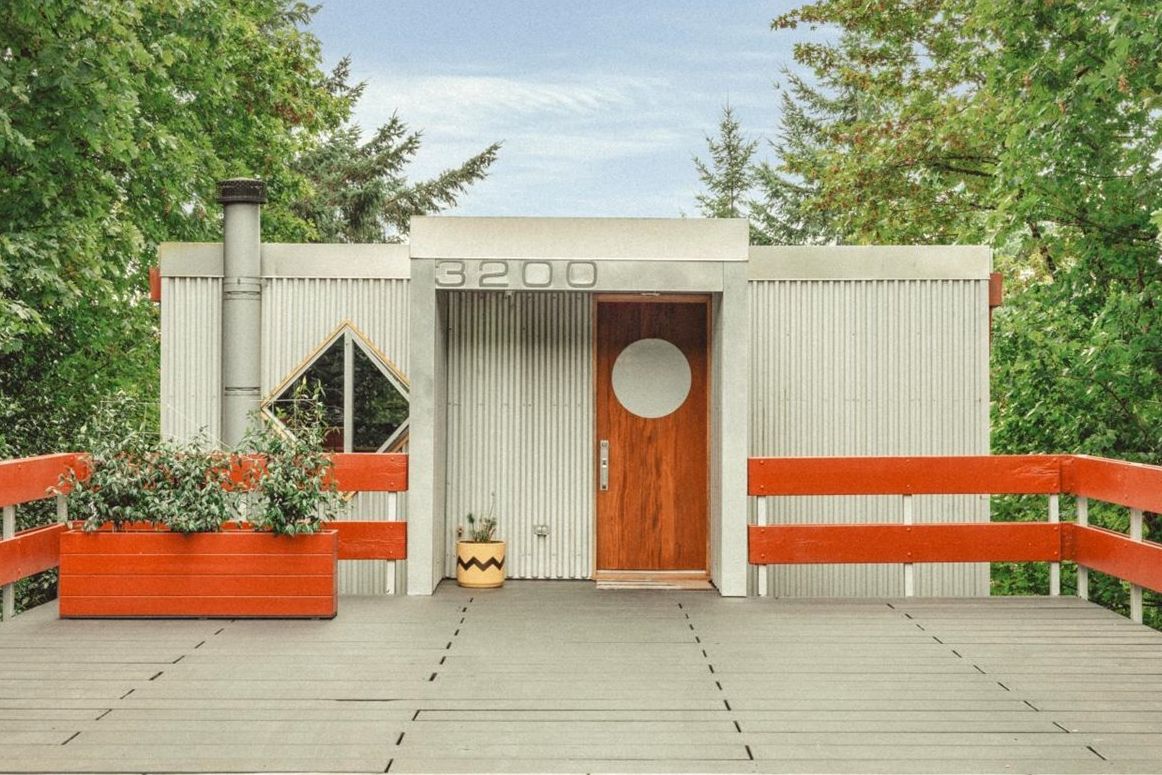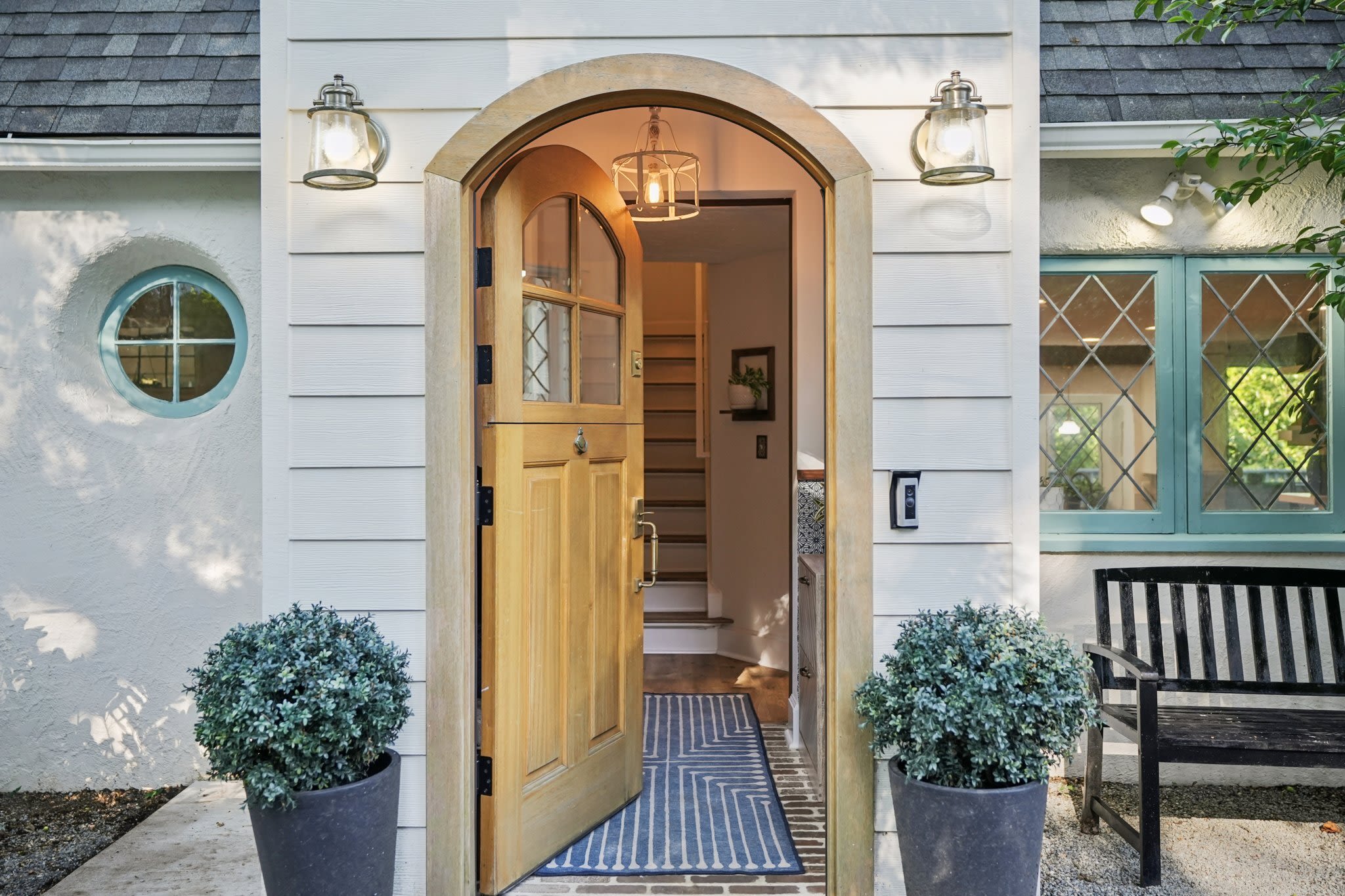Building Blocks
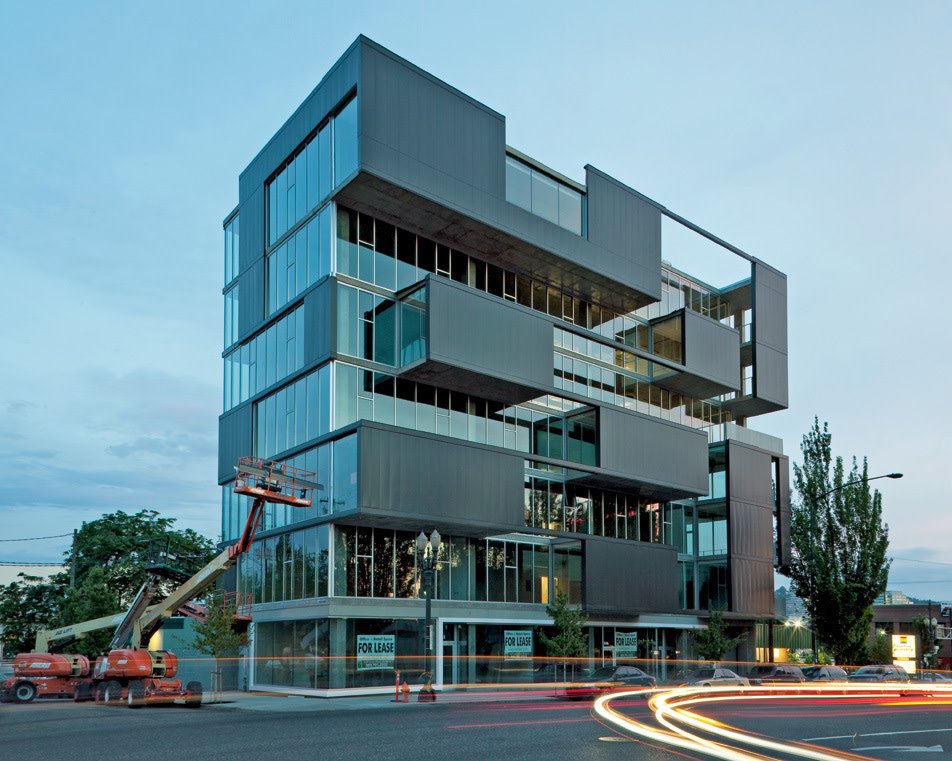
The Bside6 building by Works Partnership Architecture, on E Burnside Street.
AT THIRTY-TWO FEET HIGH AND EIGHTY-SIX FEET WIDE, the billboard-scale field of glass stretching across the west face of Ziba Design’s soon-to-open world headquarters is at once a successful company’s grand picture window on the skyline and a mirror reflecting the face of a bolder Portland future. Construction workers buzz around the building, adding to the hum of activity on the corner of NW Ninth Avenue and Marshall Street in the Pearl District. Streetcars whiz by, pedestrians stroll to cafés, and cars crest the rise of the nearby Broadway Bridge. But inside the building, all is serene. Planes of concrete slide beneath cool white walls punctuated by long slats of reclaimed Douglas fir, together forming a minimalist stage set, bathed in natural light, where Ziba’s designers, engineers, and anthropologists will convene around massive worktables to create new products, images, and ways of doing business for the likes of FedEx, UPS, Microsoft, and McDonald’s.
The surrounding neighborhood has been lauded by everyone from the Sierra Club to the New York Times for its inviting form of urbanism: the streets lined with quality retail and restaurants beneath a mix of offices, condos, apartments, and affordable housing, all peppered with public plazas and tied together by a jaunty streetcar. Which is nice. But people rarely mention the Pearl District’s architecture—a fact that’s likely to change in August, when Ziba opens its doors. The structure’s sophisticated fusion of modest scale, a welcoming street presence, and state-of-the-art sustainability—all typical ingredients in Portland buildings—is poised to quietly energize the surrounding landscape with a capital-A architectural statement.
For the firm who designed the building, Holst Architecture, this plum commission is the payoff of seventeen years of architectural ladder-climbing, rung by rung, from restaurant remodels and office renovations to townhouses and condos. But well beyond being a measure of one firm’s success, the new Ziba headquarters is merely the most prominent in a collection of fresh, dynamic buildings rising across the city in environs as diverse as gritty lower E Burnside Street and the ?bungalow-villes of North Portland. The architects—mostly ?younger firms like Works Partnership Architecture, Atelier Waechter, William Kaven Architecture, Path Architecture, and Seed Architecture Studio—share Holst’s goals of honing Portland’s longstanding traditions of eco-consciousness, lively urbanism, and thrifty building into sharper forms of architecture. “Every generation has had its great group of architects,” says Richard Potestio, a Portland architect who is an ardent follower of and occasional collaborator with members of these firms. “This is ours.”
Although the recession has ruthlessly pruned the rosters of many larger local architecture firms, these smaller shops are so far proving resilient. In many ways, they are blazing a trail parallel to that of Portland’s chefs in their prizing of simple, pure ingredients and their preference for principled experimentation over ostentatious flourishes. To them, sustainability is a quiet ethos rather than a badge or rating. And just as many of Portland’s most ambitious chefs are now drifting to lo-fi independent enterprises like sandwich shops and food carts, many of these architects are also taking the DIY approach, acting as their own developers and contractors. The result—say, a $400,000 townhouse—may not be as readily affordable as a $5 Whole Bowl of rice and beans. But in a profession where name-brand architecture can dramatically inflate the price of a new building or home, these designers are targeting, in the words of Daniel Kaven (who cofounded William Kaven Architecture with his brother Trevor), Portland’s growing “creative class, not just wealthy people or developers.”
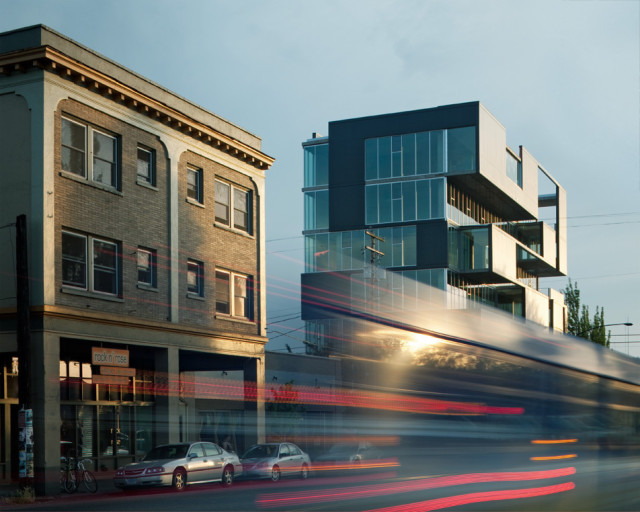
The Bside6 building on E Burnside Street, designed by Works Partnership Architecture.
In the often preening, hypercompetitive world of architecture, many of these designers are also taking an unusual one-for-all/all-for-one approach, sharing roofing tips, contractors’ names, and marketing with the same esprit de corps with which restaurateurs like Greg Higgins and Cory Schreiber began promoting the local food movement a decade ago. Through a new collective called 11xDesign, for instance, a dozen of these small firms hosted a free tour of members’ projects this past February that attracted hundreds of attendees.
Overall, theirs is a modest approach—small in scale and rooted in place and community—that’s appropriate for a city where people are more focused on quality of life than on making a fast buck. “We think the new regionalism is about addressing larger issues in a local way,” says William Neburka of Works Partnership, whose first built-from-scratch building is getting its final polish at the east end of the Burnside Bridge. “It’s lacking in excess; it’s about being cost conscious and size conscious. It’s all part of our idea of investing in a green city.”
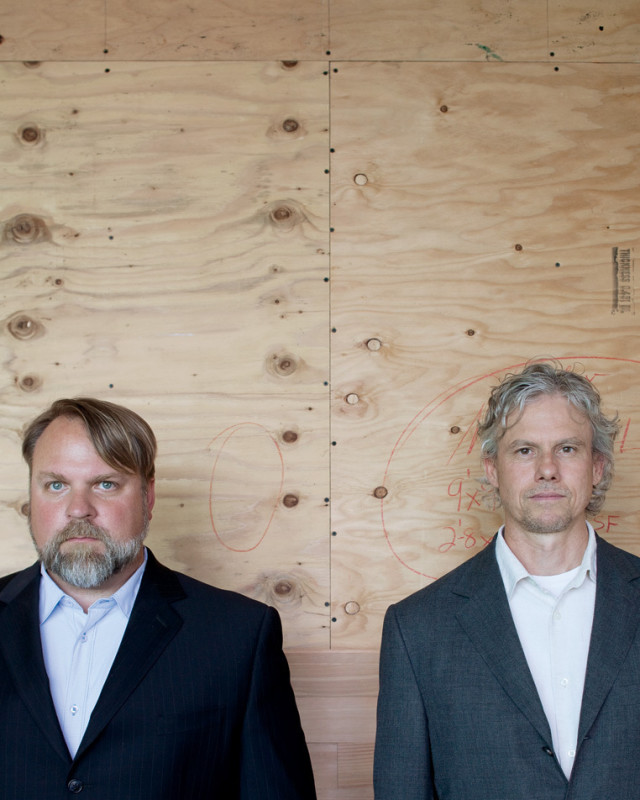
Inside ZIBA HQ with Jeff Stuhr and John Holmes of Holst Architecture.
The designers of Ziba’s new home—Jeff Stuhr and John Holmes, the founding partners of Holst Architecture—are enjoying a sunny spring morning in their far humbler digs: a subtly remodeled warehouse just off of lower E Burnside Street. A modest sign and Holst’s trademark tropical hardwood screens gently differentiate the building from its industrial neighbors. Inside, a calm murmur of activity fills the eighteen-person office.
Neither partner is one for grand statements. Husky, bearded, and earnest, Stuhr, with typical understatement, calls the Ziba commission “a continuation” of the firm’s nearly two decades of transforming small experiments in design into bigger ones. He and Holmes never aspired to build their shop into a large corporate powerhouse. In fact, quite the opposite. Wearing the graying blond curls and loose demeanor of a middle-aged surfer, Holmes describes how Holst (the name is a hybrid of “Holmes”and “Stuhr”) was born of the pair’s desire to do innovative work—and still keep the occasional afternoon golf date. “We wanted to build a good place to work,” Holmes recalls, “where people could have a balanced life and keep their integrity.”
A chocolate Labrador retriever, Jupiter, meanders through the conference room, eagerly nosing his way into the laps of those seated around the table. The atmosphere seems to befit the casual leadership role Holst has played in Portland. “Holst got there first,” says architect Paul McKean of the firm’s successful persuasion of clients, banks, and contractors to embrace more demonstrative forms of design. “A lot of people look to them.”
A series of residential remodels soon cascaded into designs for Pizzicato Gourmet Pizza, Ken’s Artisan Bakery, Reynolds Optical, and a handful of art galleries. Holst’s bold insertion of a simple drywall city of studios, classrooms, and offices into a rough-hewn Pearl District warehouse for the newly independent Pacific Northwest College of Art in 1998 was soon followed by the sumptuously crafted, wood-clad, four-story Belmont Lofts condominiums. Both projects earned rave reviews from the press and from fellow architects for meeting the highest design goals on nonprofit and speculative developer budgets. Several of the firm’s restaurant projects have featured huge, wood-framed, sliding-?glass windows at street level, adding an alluring, European sense of indoor/outdoor urbanity to Portland’s neighborhood shopping districts. Ecotrust earned a plethora of headlines as Portland’s new sustainability clubhouse and the nation’s first historic renovation to earn the US Green Building Council’s LEED Gold rating, but it was Holst that wove the structure’s precedent-setting ecological performance into a graceful interplay of historic and new in what had been a barely standing paint warehouse.
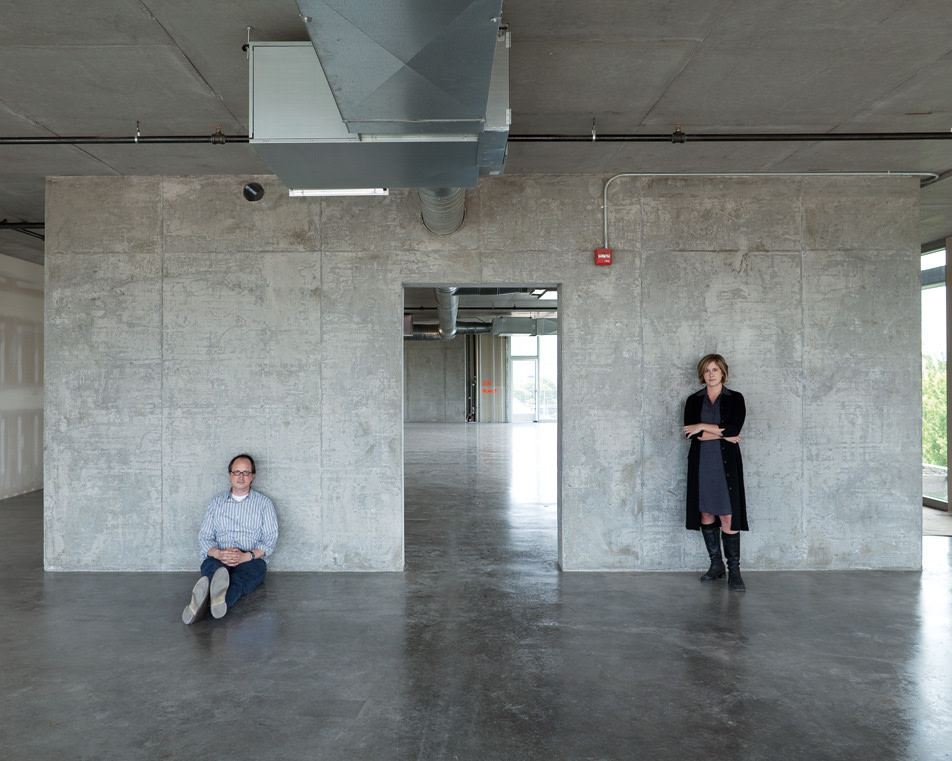
Inside BSIDE6 with William Neburka and Carrie Schilling of Works Partnership Architecture.
“Everyone is working with the same architectural ingredients. Craft is how you use those ingredients.” -CS
Now, with the Ziba headquarters, Stuhr and Holmes have experienced the terror of designing for other designers, but also the elation of working with a firm ready to more aggressively project the values both companies share. Ziba’s founder, Sohrab Vossoughi, describes the building’s interior with urban analogies—streets connecting neighborhoods where tribes of creatives will conjure new products and brand images. But the building’s architecture also reaches exuberantly into the outside world. The huge, cantilevered picture window, extending three and a half feet over the sidewalk, provides rain cover to those walking beneath it, while inviting passersby to look in. In an auditorium with its own entrance on NW Marshall Street, Ziba plans to offer a community gathering space, where it will host discussions with artists and designers, among other things. “We don’t want to insulate ourselves within,” Vossoughi says. “We want a connection to the city and neighborhood. Holst shares our same values and work culture—they have a crafts mentality of engaging in the city with care, not about showing off.”
“When we started our firm four years ago, we could tell Holst was different,” says Carrie Schilling, a principal at Works Partnership Architecture, another small East Side office following in Holst’s wake. “Other firms wanted to build a business. Holst was building a practice, and they always put craft first.”
Mere steps away from Holst’s office, Works Partnership is putting its own ideas to the test with the Bside6 building on ?E Burnside Street, seven stories of work studios and retail space that seem to float above the street in a Tetris-like façade. As with Ziba’s headquarters, huge, floor-to-ceiling panels of glass will offer glimpses of the activity inside. The energy of the building’s overall form echoes the patterns of passing traffic below. With ribbons of dark-gray metal playing hide-and-seek with sleek glass, the structure mixes sexy and stern like no other building in the city. Yet Works Partnership’s bold, column-free reinterpretation of the lower East Burnside tradition of covered sidewalks nestles the building like a puzzle piece into the street’s ramshackle collection of bars, vintage retailers, and coffee shops as seamlessly as the new Ziba headquarters does in the far tonier Pearl.
Neburka notes with pride that the building’s budget fits this low-rent neighborhood as well. Indeed, while Holst has long been known for its willingness and ability to work on tight budgets, Works Partnership takes it one step further, considering itself a firm that can craft modern architecture on food stamps. “Holst asks clients, ‘What is it you like about meat and potatoes?’” Neburka says, laughing. “We say, ‘Do you know how much meat costs? You can do wonders with salt instead.’”
For these emerging firms, the budget question is rarely how much money they can spend, but how little they can get away with investing while still reaching their considerably high ideals—after all, it’s often their own money on the line. Atelier Waechter founder Ben Waechter, for instance, has applied his six years of experience working for top Portland firm Allied Works and for the world-renowned Renzo Piano Building Workshop to the problem of designing two rowhouses just off of N Williams Avenue. In what he and his wife, realtor Daria Crymes, dubbed the “Z-Haus,” so named for its interior pattern of zigzagging spaces, Waechter raised the repetition of rooms and building parts found in any low-budget building to a geometrically precise elegance.

At the Z-HAUS with Ben Waechter and Daria Crymes of Atelier Waechter.
“Regionalism is about being responsive to context, to the neighborhood, and to the site.” -BW
The home is a simple sequence of six identical fourteen-foot-by-nineteen-foot rooms connected by half flights of stairs rising around a central core of bathrooms, a kitchen, and a laundry room. With windows placed in corner locations for maximum natural light, the character of each space is determined solely by its unique views of neighboring houses, treetops, and sky. At first glance, the sternly rectilinear structure seems incongruous with the peaked-roofed cottages it sits between, but closer scrutiny ?reveals the Z-Haus’s careful tailoring. “The faces of the Z-Haus, both front and back, are perfectly aligned with the houses to either side,” Waechter explains. “And we used painted wood siding, since that’s the vernacular of the neighborhood.”
Waechter served as his own contractor, playing every penny to maximum effect with such carefully chosen details as innovative German windows that are made of nontoxic, recyclable materials and tilt open for ventilation, or the bathrooms’ warmly pigmented, hand-textured stucco. The Z-Haus is also chock-full of environmentally sound building methods and materials, from its rain-screen siding that keeps water out while allowing air in, to natural air-conditioning that draws cool air up through the house via a central vent. Waechter shrugs off the idea that he’s done anything unusual. “Urban infill by its very nature is green,” he says. “The architectural style is all about keeping it as compact and simple as possible.”
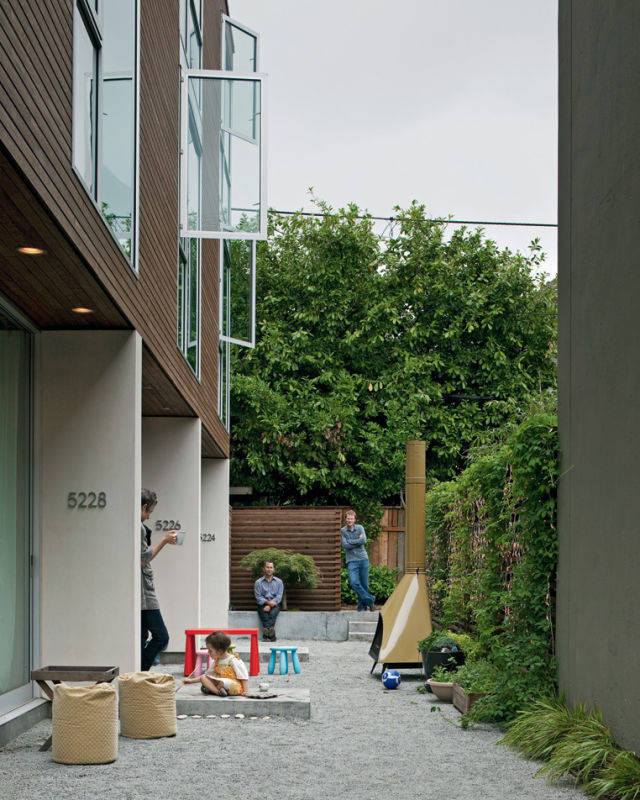
At WILLIAMS FIVE with Ben Kaiser and Corey Martin of Path Architecture.
Image: John Clark
Less than a mile northwest of the Z-Haus is Path Architecture’s Williams Five, a quintet of live/work townhouses clad in swaths of rich cedar wood wrapped around crisp white-stucco planes. Aligned perpendicularly to the street on a 5,000-square-foot lot, the modest 1,500-square-foot units feel expansive, with generous windows that open onto communal courtyards where residents mingle and share meals. “We like to find a site where we can put five units where there ordinarily would only be one single-family house,” says Path partner Corey Martin. “You create an outdoor courtyard that brings everyone together, and it becomes a really great, inspiring place to live.” Sustainability is, again, intrinsic to the project, which features high-efficiency heat pumps and a rainwater management system. Just don’t call it a marketing tool. “‘Green marketing’ kind of annoys us,” Martin says. “It’s just what you do. You don’t use it as a selling tool.”
Nearby, just off of NE 45th Avenue on Ainsworth Street, Darin Dougherty of Seed Architecture is putting the finishing touches on his SIPs House, named for the structural insulated panels made of high-density insulation and plywood that create the home’s angular framework. Dougherty clad the house in coppery, virtually indestructible sheets of Cor-Ten steel and planks of wood salvaged from two old barns he bought on Craigslist. “It’s important that my projects have a connection between the exterior and interior,” he says, “whether it’s materials that speak to nature or floor-to-ceiling glass doors.” Indeed, set back from the road in a semirural stretch of the neighborhood, the house looks like a modern interpretation of a barn.
However divinely inspired, innovatively designed, and exactingly crafted their projects may be, these architects must still survive a recession many older colleagues say may get worse than that of the 1980s, when roughly 40 percent of Portland’s architects lost their jobs. Although Dougherty’s SIPs House will shortly hang its own “For Sale” sign in a beleaguered real estate market, he remains optimistic. “There’s a certain level of quality and form that will weather any economy,” he says. “There are so many creative people in Portland who understand the value of design, we shouldn’t have too much trouble.”
Dougherty’s confidence is buoyed in part by the small but critical financial successes his colleagues are enjoying. The market may have forced Path’s Corey Martin and his partner to switch Williams Five from condos to apartments, but all five units are now rented. Another of Path’s recently completed projects, the Park Box, which faces DeNorval Unthank Park, is also at capacity. Nearby, Waechter has sold half of the Z-Haus (he will live in the other half). Works Partnership’s Bside6 will be 40 percent occupied when it opens—not all that bad considering such downtown projects as the First & Main building, which is nearly complete without a single tenant signed, or the Park Avenue West tower, which remains for now a giant hole in the ground. And—no small feat—Holst has survived the downturn without a single layoff.
Sure, the small size of these firms’ projects and their offices’ low overhead help. But so, too, might their belief that Portland’s commitment to sustainability and pride of place can, finally, be fused into a bolder, more confident brand of architecture. “We have a collective urban consciousness,” says Neburka matter-of-factly, “that Portland is the place that can set the standard in architecture for how we treat the planet.”

